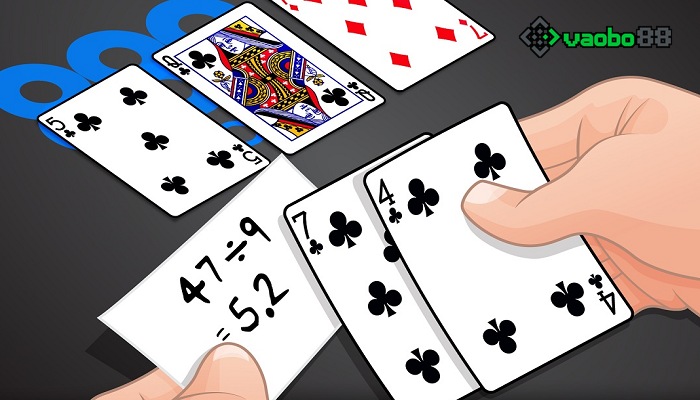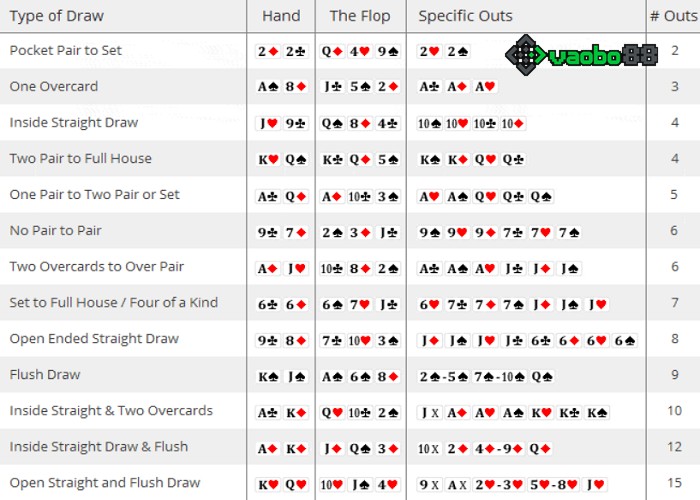Calculating Poker Odds is considered one of the factors that helps players easily win.
However, for players who are new to this intellectual game, it may not be easy to grasp.
Therefore, let’s start to seriously understand the simple concepts of Outs, Odds, and accurately calculate our chances in each bet.
What are Outs in Poker?
Outs are the player’s expectations for a specific card to appear as desired and yield high results.
If you have experienced online Poker for money multiple times, you will often wait for a specific card to complete a Straight or Flush and win big.
Typically, in the Flop or Turn round, you will often hope for these useful cards, which are Outs.

However, you should also note that only those cards that, when appearing, will complete a strong combination are called Outs.
These combinations will help us easily gain an advantage in the next round.
In cases where you can only form a pair, even if it is revealed in the next round, it is not called Outs.
The Most Accurate Way to Count Outs
Reading the concept, you may find it difficult to visualize the concept of Outs, which can inadvertently make calculating odds in Poker a bit challenging.
Therefore, let’s look at the following practical example to count Outs accurately.
You see the hole cards: 6♣️ 7♣️
The community cards on the table: J♣️ A♣️ 5♦️
In the Flop, the player is waiting for one more card to create a Flush. If a ♣️ card appears in the Turn or River, the Flush will be completed.
In this situation, you see 4 suited cards in the hole cards and 2 community cards on the betting table. In a 52-card deck, there are only 13 suited cards.
Therefore, if a ♣️ card appears, there will be 9 cards left => 9 opportunities to complete the Flush, which is 9 Outs.
Understanding and calculating Outs will allow players to know their chances of winning in the game.
In reality, the more Outs that appear, the higher the evaluation, and the greater the player’s chance of winning.
Odds and How to Calculate Outs in Poker
To calculate Poker odds, you should not only learn about Outs but also Odds, which is a term in Poker that you should know.
Odds are the likelihood of the expected cards appearing so that players can win in the next round.
Understanding this concept & the statistics in Poker will make it easier to identify winning opportunities in games.
How to calculate outs in Poker is not too difficult, and we will see Odds appear in 2 different forms:

1/ Probability in Poker in % form
Odds in % form will show you the chance of winning represented by a specific and most accurate number.
To calculate, we will follow these steps:
- Step 1: According to the concept and example above, calculate the specific number of Outs.
- Step 2: Take the number of Outs divided by the number of unseen cards, and then Odds will appear with the unit of %.
You find it quite hard to visualize, right? Then let’s return to the example above:
- Step 1: You have specifically calculated that there are 9 Outs.
- Step 2: Start by determining the number of unseen cards on the table. Specifically, in this situation, we have 2 hole cards and 3 community cards, so there will be 47 unseen cards remaining in the Flop round.
- Step 3: The player can calculate the probability of drawing a card of suit ♣️ in the Turn round as: 9/47= 0.19= 19%
See more: Tight Poker – Types of Poker play: 4 Player categories & Advantages – Disadvantages
2/ Calculating Poker probability in ratio form
In addition to the specific % form, we can also calculate the probability of drawing a card in Poker in ratio form.
You will see Odds displayed in the form: Probability of losing (not hit) : Probability of winning (hit).
To make it easier to visualize, we can go back to the example once again. The player has calculated the probability of drawing the desired card to form a Flush in the Turn round is 19%.
This means that the probability of not hitting will be 81%. Odds in ratio form will be displayed as: 81 : 19 = 4 : 1.
A probability of 4 : 1 means that on average, in 5 times, the player will see 4 times without a chance to win and 1 time with a chance to win.
3/ Quick way to calculate probability in Poker
Calculating probability in Poker using the formulas above is not too difficult. Just stay calm for a bit or use it multiple times, and we will get the exact number right away.
However, the time for a Poker hand is not much, so let’s apply a calculation method that, while not truly accurate, is quite quick:
- Probability of getting the desired card in the next round = Number of Outs x 2.
- Probability of getting the desired card in the remaining 2 rounds: Number of Outs x 4.
For a specific example:
You can form a flush with 9 cards ♣️ equivalent to 9 Outs. According to the quick calculation method, the chance of completing the Flush will be 9 x 2 = 18%.
Similarly, for the next 2 rounds, you can get a hit of: 9 x 4 = 36%.
Detailed Poker probabilities in some common cases
No matter how fast the probability of Poker is, when entering a tense game, you may still feel confused, so I will provide specific Odds in some common situations.
Recording or memorizing this table will allow you to quickly calculate and come up with specific strategies:
| Number of Outs | Next Round Odds (Flop-River) | Odds for the Next 2 Rounds (Flop-Turn/ Turn-River) | Example |
| 1 | 46:1 | 22.5:1 | |
| 2 | 22.5:1 | 11:1 | Waiting for a set |
| 4 | 11:1 | 5:1 | 1 pair – waiting for 2 pairs or a set |
| 5 | 8:1 | 4:1 | Waiting for a 2-ended straight |
| 8 | 5:1 | 2:1 | Waiting for a flush |
| 9 | 4:1 | 2:1 | Waiting for a flush and a straight |
| 12 | 3:1 | 1:1 | |
| 13 | 2.5:1 | 1:1 | |
| 14 | 2.5:1 | 1:1 | |
| 15 | 2:1 | 1:1 | Waiting for a flush and a 2-ended straight |
Conclusion
Calculating Poker Odds will no longer be too difficult for beginners if they have carefully read the information provided above.
Understanding the concept and applying it in practice with each position in Poker will surely allow you to experience hands where you have a higher chance of winning.








